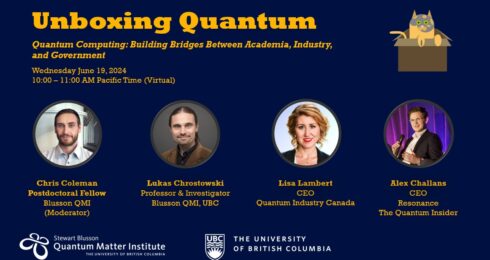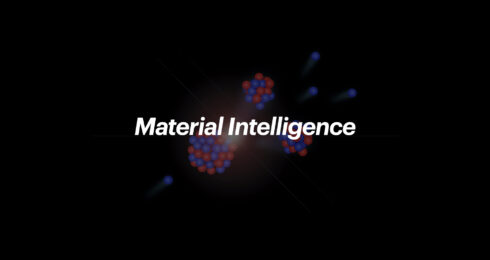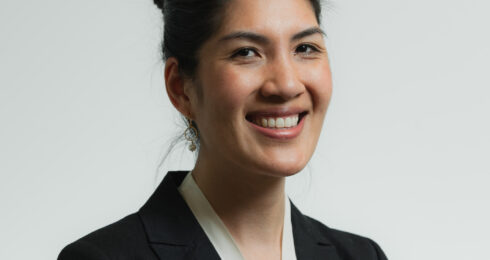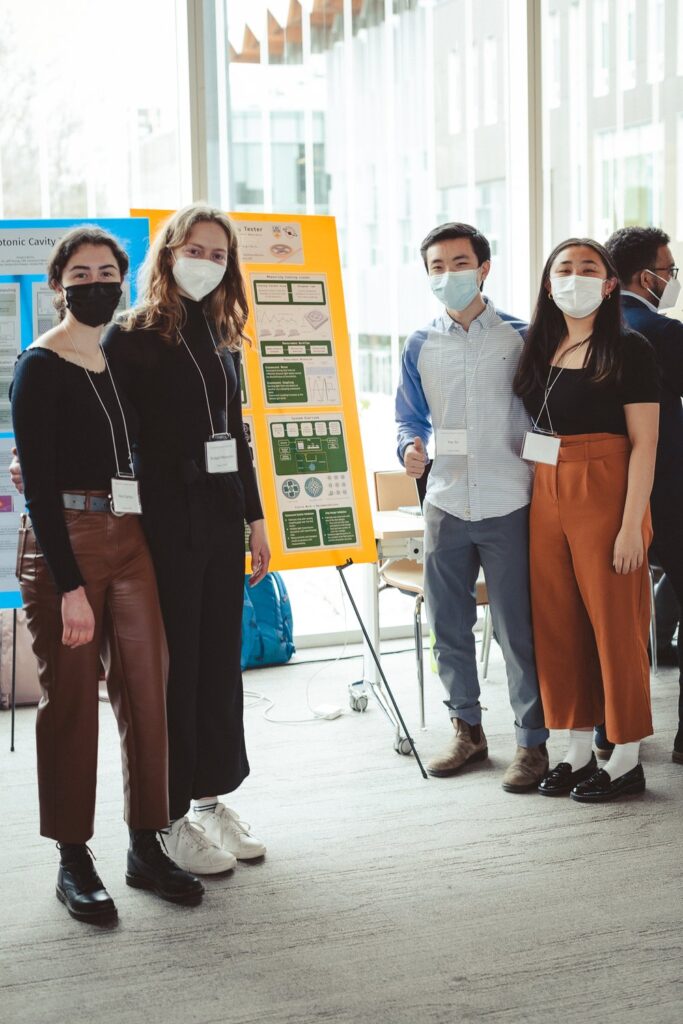
Pictured (left to right): Alexi Garbuz, Bridget Meyboom, Ray Su, and Dora Yang, the undergraduate research team who worked on the LIGO project, demonstrate their work at the UBC Engineering Physics 2022 Final Project Showcase. Image credit: Lou Dahl.
Undergraduate students make valuable contributions to research at the Stewart Blusson Quantum Matter Institute (Blusson QMI) through programs such as Science Co-Op, Quantum Pathways, and Honours and Capstone projects. These talented and curious undergraduate researchers enhance quantum materials and technology research and develop skills that are sought by academic supervisors and industry employers. The relationship is mutually beneficial: students learn to focus their research questions, design projects, and build deliverables that serve research interests as well as their own career development.
Dylan Gunn has been the Director of the Engineering Physics Project Lab in UBC’s Faculty of Applied Science for four years, and in that time has developed a close relationship with Blusson QMI Principal Investigators. The Project Lab, which has been connecting undergraduate students in Engineering Physics with projects across the faculties of Applied Science and Science at UBC since 1978, is a unique entity in that it has a dedicated lab in the Hennings building with a full-time staff dedicated to assisting students with all aspects of their projects, from the background research to using a waterjet cutter.
“The program has a reputation for being challenging, and graduates of the program are highly in demand,” said Gunn, who was an Engineering Physics undergraduate student when Jeff Young was Director of the program. “A third of our students go on to graduate school, and about two-thirds go on to industry roles; a lot of really cutting-edge companies are looking for the types of skills that these students demonstrate through these projects.”
“Companies are realizing that grades are less important than what a candidate can do,” said Gunn. “Employers and graduate programs increasingly want to see experiential learning and projects that demonstrate someone’s potential.”
Applying Engineering Physics to a Grand Challenge
For researchers like Kirsty Gardner, a postdoctoral fellow who works with Principal Investigator Jeff Young, Capstone project teams offer unique expertise in Engineering Physics that is helpful as she works to devise novel materials to improve gravitational wave detectors as part of the LIGO project and Blusson QMI’s Atomistic approach to emergent properties of disordered materials Grand Challenge.
The Laser Interferometer Gravitational-Wave Observatory (LIGO) is a US-based gravitational-wave research and detector development, observation, and data analysis facility. The Grand Challenge team at Blusson QMI is working with colleagues at UBC to develop better optical coatings for the Advanced LIGO detectors and future ground-based gravitational-wave observatories.
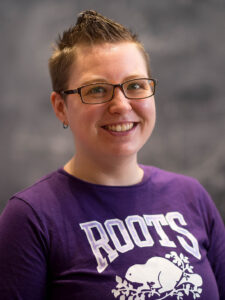
Pictured: Kirsty Gardner
The students who worked with Gardner—Alexi Garbuz, Bridget Meyboom, Dora Yang, and Ray Su (pictured above)—worked on a project titled High Throughput Testing of Coating Mechanical Loss for Advanced LIGO.
“One of the big things is that they were able to conduct research and do some of the setups for a different way of measuring the mechanical vibration of specific thin-film materials to understand their properties,” said Gardner. “What we do is apply the thin-film over a microdisc and then cause the disc to vibrate. If we can measure how the vibration evolves, we can learn about the properties of that material.”
The team was able to develop several deliverables relevant to the LIGO project, contributing useful tools that will remain after they have moved on.
“One of the things that one of the students did was devise an elegant way to analyze the data we collected,” said Gardner, who co-supervised the project with Matthew Mitchell (a fellow postdoc) and Jeff Young. “The vibrating signal that we’re looking for is quite small, and it can be somewhat tricky to filter out this signal from the background. The students ran simulations to determine what the signal will look like and then set up a system that mimics the expected signal. They took that signal and analyzed it to see if they could recover the information that we wanted to get from that signal.”
The signal occurs at a specific frequency, and over time, it weakens and can become lost in the noise of the measurement equipment.
“A big part of what they were working on was figuring out where the signal drops and we can’t measure it anymore,” said Gardner. “By separating the signal from the noise, the students were able to measure it for as long as possible, which ultimately means we’ll be able to give more accurate information to the LIGO team.”
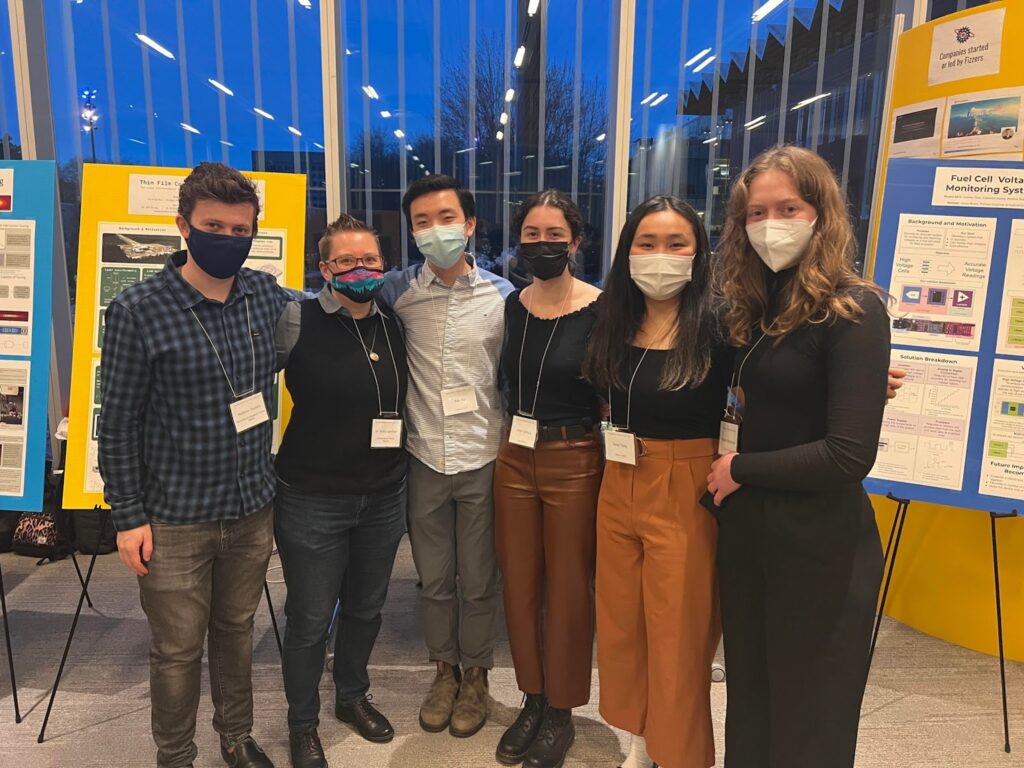
Pictured, left to right: Matthew Mitchell (co-supervisor), Kirsty Gardner (co-supervisor), Ray Su, Alexi Garbuz, Dora Yang, and Bridget Meyboom. Image credit: AnnaLisa Meyboom.
Honours projects offer graduate-style research as an undergrad
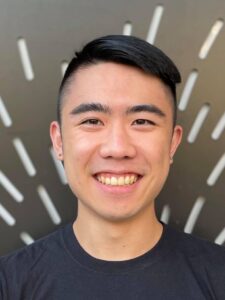
Pictured: Julian Ding
Julian Ding, whose background is in Computer Science and Physics, used his Honours project as an opportunity to learn more about quantum computing. Ding, who sought supervision by Robert Raussendorf after being impressed with the Professor’s teaching in a Science One class years prior used his coding experience to work on a numerical simulation of a quantum error-correcting code on a quantum architecture proposed by Raussendorf, Young, and graduate student Xiruo Yan.
“We used the simulation to test the performance of the Kitaev surface code on this proposed quantum computer before it was built,” said Ding. The result is a Python-based scheme that makes quantum processing more robust by encoding qubits to find a probable pattern of errors and correct them in real-time.
Ding has recently graduated from UBC and secured a role in the software development industry.
Rio Weil also used his Honours project to learn more about quantum computing in another project with direct ties to Blusson QMI Grand Challenges. His project, supervised by Raussendorf, sits at the intersection of theoretical and experimental quantum computation.
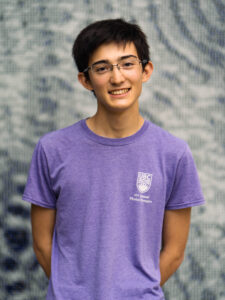
Pictured: Rio Weil
Weil’s project aimed to address measurement-based quantum computing based on the groundbreaking theory Raussendorf proposed with Hans J. Briegel that proposed measurement-based quantum computing with cluster states. Weil’s work focused on how to use quantum computing to determine where quantum computing gets its advantage.
Using IBM’s quantum devices, Weil looked at algorithms to efficiently generate resource states to measure their computational power experimentally.
“One thing that intrigues me about the field as a whole is that it’s very new: we’ve seen big investments in quantum computing in recent years, but it’s still a very new area of research, with a lot of fascinating fundamental questions to explore,” said Weil. “We still don’t really understand what makes quantum computing so potentially powerful, so this is an exciting time to be studying in the field.”
Weil will continue to work with Raussendorf as he starts his Master’s studies in the fall.
Projects put undergraduate training to work
Blusson QMI offers several opportunities for undergraduate researchers to engage with quantum science at UBC, from programs such as Quantum Pathways, which offers skills training and mentorship to historically excluded groups, to programming for recipients of NSERC’s Undergraduate Student Research Awards. For undergraduate students seeking internships, looking ahead to graduate school, or aiming to launch their careers in industry, research experience offers a competitive advantage.
- Related: 2021 Summer Undergraduate Talks
“When we get very good students in our program, we often send them to Blusson QMI where we know they are going to be working on really cool projects,” said Gunn. “It’s valuable for the students to work with Blusson QMI investigators who help them make valuable connections between their theoretical learning and potential applications.”
“Many of the undergraduate students that we work with are very advanced, and in some cases are already working at a graduate level,” said Jeff Young, Professor in UBC’s Department of Physics and Astronomy. “Capstone or Honours projects are the most important component in an undergraduate scientist’s degree program for those looking to go enroll in graduate programs or seek careers in industry. The students we work with are very high-caliber, and the work that they do is as valuable to Blusson QMI as the experience is to them.”
